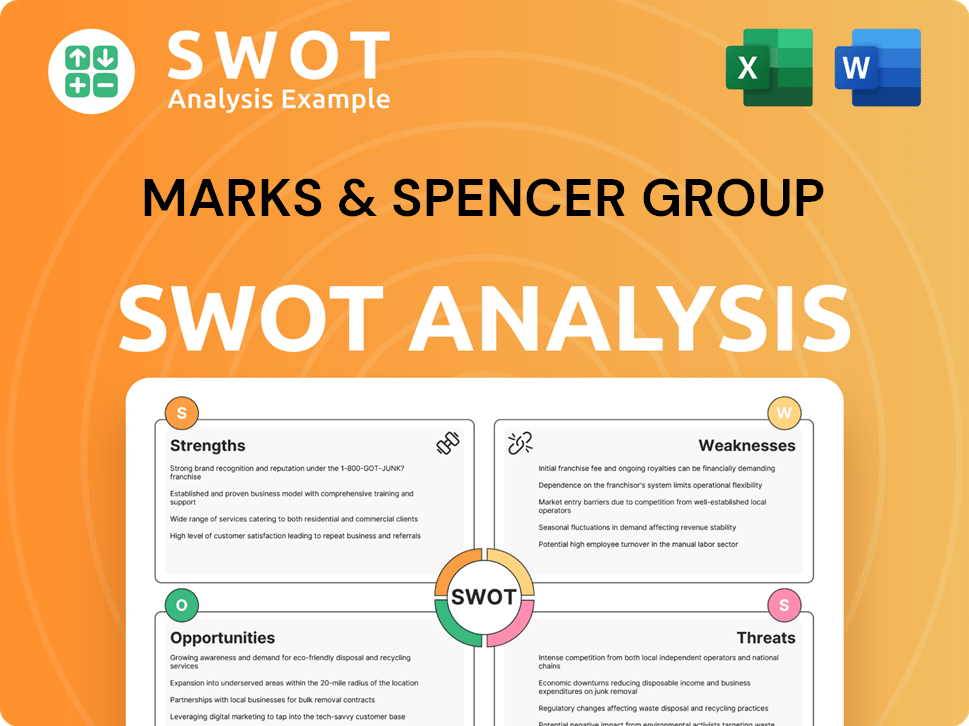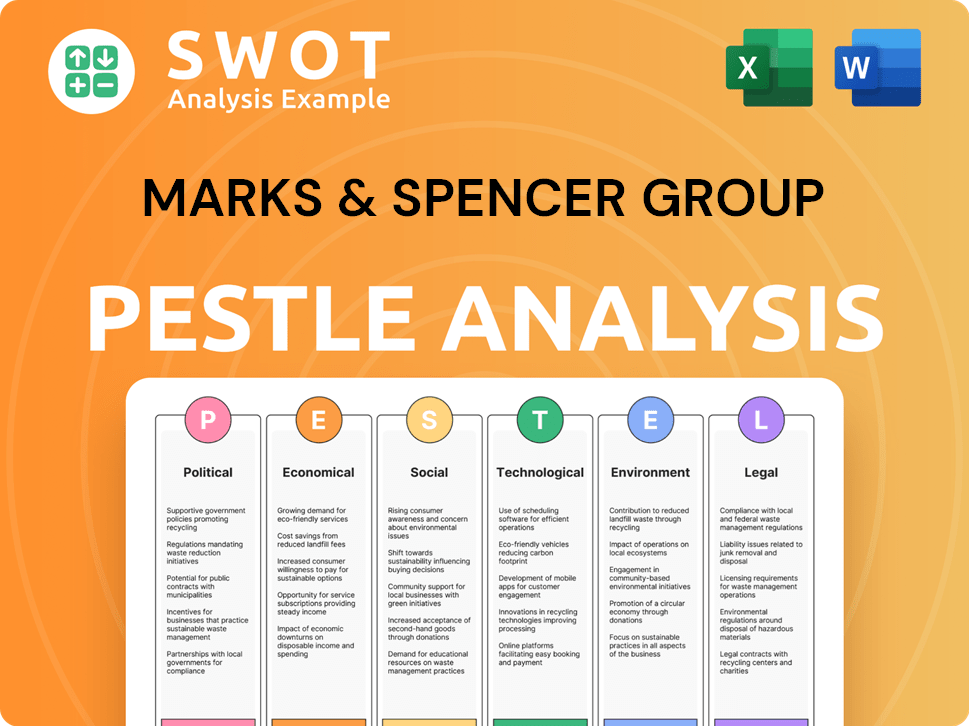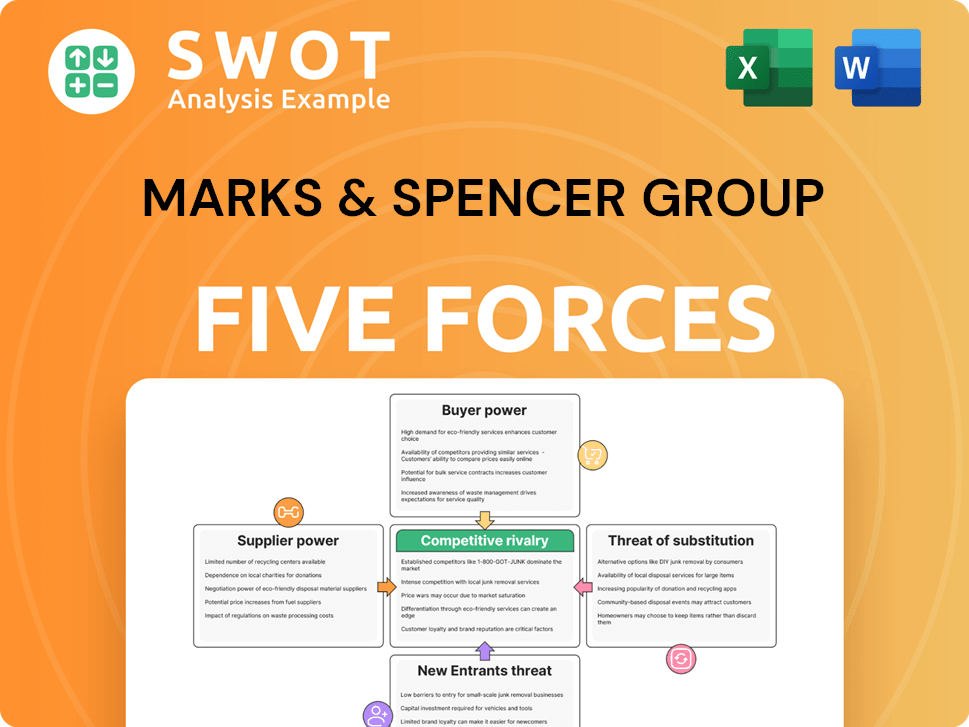Marks & Spencer Group Bundle
Can Marks & Spencer Reclaim Retail Dominance?
Founded in 1884, Marks & Spencer (M&S) has a rich history as a British retail icon. Today, in a rapidly evolving market, M&S is undertaking a significant transformation to ensure its future success. With a focus on digital innovation, sustainable practices, and strategic partnerships, M&S is aiming to redefine its place in the competitive landscape.

This exploration into the Marks & Spencer Group SWOT Analysis will delve into the strategic initiatives driving the company's growth. We'll examine M&S's recent financial performance, expansion plans, and how it's navigating challenges within the UK Retail Market. Understanding the Marks & Spencer Growth Strategy is crucial for anyone seeking insights into the future of retail.
How Is Marks & Spencer Group Expanding Its Reach?
The company is actively pursuing an aggressive expansion strategy, focusing on both physical stores and online presence, which is crucial for its long-term success. This strategy is a key element of the overall Marks & Spencer Growth Strategy, aiming to enhance its market position and drive revenue growth. The expansion initiatives are designed to meet evolving consumer demands and strengthen its presence in the UK Retail Market.
The company's expansion plans include significant investments in new store openings and upgrades. These efforts are part of a broader strategy to modernize its retail footprint and improve the overall customer experience. This approach is intended to capitalize on opportunities within the retail sector and maintain a competitive edge. These initiatives are a key component of the M&S Future Prospects.
In 2025, the company plans to open 20 new shops, creating thousands of jobs. This expansion includes converting former Debenhams sites into full stores. This builds on a substantial investment of £480 million into 'bigger and better' shops during 2023 and 2024. In 2024, the company invested £90 million to open seventeen new and improved stores across London, creating 450 new jobs. This follows a £50 million investment in stores across the Northwest of England.
The company is increasing its food store count from 316 to 420, focusing on locations with convenient access and parking. New food halls are planned for locations like Abingdon and Cannock in late 2025. A 22,000 sq ft food hall is expected to open in Godalming in summer 2026.
The aim is to have half of the store estate in the renewal format by 2027/28. These new and renewed stores have consistently performed well, exceeding targets for three consecutive years. These initiatives are a key part of the Marks and Spencer Company's growth strategy.
The company is significantly enhancing its online presence to increase the M&S.com share of Fashion, Home & Beauty sales from 34% to 50% in the medium term. Online sales growth accelerated in 2024/25.
The company is rebalancing marketing towards social channels and launching top-tier partner brands online, which exceeded £200 million in sales for the first time in 2024/25. Recent additions include Hush, Tommy Hilfiger, and Calvin Klein.
The company is focused on improving its online offer and experience to transform Fashion, Home & Beauty into a fully omnichannel business. This includes providing best-in-class delivery and returns to enhance customer satisfaction and drive sales. For a deeper dive into the competitive landscape, consider reading about the Competitors Landscape of Marks & Spencer Group.
- Enhancing the online platform.
- Expanding the range of partner brands.
- Improving delivery and returns processes.
- Investing in store renovations and upgrades.
Marks & Spencer Group SWOT Analysis
- Complete SWOT Breakdown
- Fully Customizable
- Editable in Excel & Word
- Professional Formatting
- Investor-Ready Format

How Does Marks & Spencer Group Invest in Innovation?
The company is actively leveraging technology and innovation to drive sustained growth and enhance its customer experience. A core focus is digital transformation, with a commitment to upgrading the digital experience to fuel growth across clothing, home, and beauty. This includes re-imagining its website and app to improve availability and fulfillment.
The company's strategy involves expanding its partnerships and investing in core digital and technological infrastructure. This approach is designed to boost operational efficiency and enhance customer engagement. The company is also focused on sustainability, aiming to reduce its environmental impact while meeting evolving consumer expectations.
The company's strategic initiatives are aimed at adapting to the changing retail landscape and securing its position in the market. By focusing on digital innovation, sustainability, and customer experience, the company aims to achieve long-term growth and maintain its competitive edge. For a deeper dive into their marketing strategies, see the Marketing Strategy of Marks & Spencer Group.
The company is committed to upgrading its digital experience to drive growth. This includes re-imagining the website and app to improve availability and fulfillment. The company is investing in core infrastructure in digital and technology to enhance customer experience and operational efficiency.
The company has been expanding its partnership with First Insight, integrating its customer-driven AI intelligence engine. This integration spans product development, design, pricing, merchandising, and marketing. The aim is to enhance profitability and advance sustainability goals.
The company is implementing AI, including computer vision, in over 500 stores to optimize store operations. In 2023, it collaborated with SymphonyAI Retail CPG for its Store Intelligence capabilities. This technology helps in improving efficiency and customer service.
The company has partnered with Decoded to launch a retail data academy, intending to provide over 1,000 staff members with digital skills. The Data Technician Apprenticeship, launched in December 2020, equips employees with data and digital capabilities. Digital Labs, initiated in March 2013, accelerates retail technology innovation.
The company plans to launch over 200 new products annually that meet health and sustainability standards. In 2024, it introduced a series of plant-based food products, contributing to a 15% increase in sales in their vegetarian and vegan categories. This demonstrates a commitment to meeting changing consumer preferences.
The company has invested £25 million in sustainability initiatives, such as reducing packaging waste and enhancing supply chain transparency. It has committed to achieving a net-zero carbon footprint by 2040 and aims for 100% of its packaging to be recyclable, reusable, or compostable by 2025. By 2025/26, it aims to redistribute 100% of its edible surplus food, with 85% progress already made.
The company's investments in technology and innovation are central to its growth strategy, focusing on digital transformation, AI integration, and sustainability. These investments aim to enhance customer experience, improve operational efficiency, and meet sustainability goals.
- Digital Transformation: Re-imagining website and app to improve availability and fulfillment.
- AI Integration: Using customer-driven AI intelligence across product development, design, and marketing.
- Store Optimization: Implementing AI, including computer vision, in over 500 stores.
- Digital Skills: Launching a retail data academy to equip staff with digital skills.
- Product Innovation: Launching over 200 new products annually that meet health and sustainability standards.
- Sustainability: Investing £25 million in initiatives, aiming for net-zero carbon footprint by 2040.
Marks & Spencer Group PESTLE Analysis
- Covers All 6 PESTLE Categories
- No Research Needed – Save Hours of Work
- Built by Experts, Trusted by Consultants
- Instant Download, Ready to Use
- 100% Editable, Fully Customizable

What Is Marks & Spencer Group’s Growth Forecast?
The financial outlook for Marks & Spencer (M&S) appears robust, reflecting a sustained period of growth. The company's performance in the 52 weeks ending March 29, 2025, showcases significant improvements across key financial metrics. This positive trajectory is supported by strategic initiatives and a focus on operational efficiency, positioning M&S favorably within the Mission, Vision & Core Values of Marks & Spencer Group.
M&S has demonstrated a strong financial performance, delivering its third consecutive year of growth. For the 52 weeks ended March 29, 2025, the company reported a profit before tax and adjusting items of £875.5 million, marking a 22.2% increase from £716.4 million in 2023/24, and the highest in over 15 years. Statutory revenue for the same period was £13.8 billion, up 6.0% from FY 2024.
Food sales experienced an impressive growth of 8.7%, reaching £9.0 billion. This segment's adjusted operating profit was £484.1 million, resulting in a margin of 5.4%. This indicates strong consumer demand and effective operational strategies within the food division.
Fashion, Home & Beauty sales also showed positive momentum, increasing by 3.5% to £4.2 billion. The adjusted operating profit for this segment was £475.3 million, with a margin of 11.2%, highlighting the profitability of these product categories.
International constant currency sales decreased by 7.1% to £0.7 billion. The adjusted operating profit for the international segment was £46.3 million. This decline suggests challenges in international markets, which the company is addressing through strategic adjustments.
The adjusted return on capital employed (ROCE) improved significantly, rising to 16.4% from 14.1% in 2023/24. This improvement demonstrates efficient capital allocation and enhanced profitability across the business.
Looking ahead, M&S is planning increased capital investments in 2025/26, with a net investment of £600 million-£650 million, to fuel growth and resilience. Analysts project an average revenue growth of 3.1% per annum over the next three years. For fiscal year 2025, sales are expected to reach as high as £14.6 billion by 2026, with a potential 42% gain in earnings per share. The company aims to achieve a 5% annual growth in operating profit over the next three years, with a targeted annual revenue growth rate of 3%. Structural cost reductions of approximately £120 million were achieved in 2024/25, with an ambition to achieve cumulative savings over £500 million by 2027/28.
M&S is increasing capital investment in 2025/26 to fuel growth and resilience. The planned investment of £600 million-£650 million (net of disposals) highlights the company's commitment to long-term expansion and strategic initiatives.
Analysts forecast revenue to grow by 3.1% per annum on average over the next three years. This positive outlook reflects confidence in M&S's strategic direction and market position within the UK Retail Market.
For fiscal year 2025, analysts expect sales to reach as high as £14.6 billion by 2026, with a potential 42% gain in earnings per share. This indicates strong potential for shareholder value creation.
The company aims to achieve a 5% annual growth in operating profit over the next three years. This target underscores M&S's focus on improving profitability and operational efficiency.
Structural cost reductions of approximately £120 million were achieved in 2024/25, with an ambition to achieve cumulative savings over £500 million by 2027/28. These savings will contribute to improved margins and overall financial health.
M&S's strategic focus includes sustained revenue growth, improved profitability, and efficient cost management. These initiatives are designed to ensure long-term success and enhance shareholder value within the competitive Retail Industry Analysis.
Marks & Spencer Group Business Model Canvas
- Complete 9-Block Business Model Canvas
- Effortlessly Communicate Your Business Strategy
- Investor-Ready BMC Format
- 100% Editable and Customizable
- Clear and Structured Layout

What Risks Could Slow Marks & Spencer Group’s Growth?
The Marks & Spencer Company faces several risks and obstacles that could affect its growth strategy and future prospects. These challenges range from cyber threats to intense competition in the retail industry. Addressing these issues is crucial for the company's long-term success in the UK retail market and beyond.
One of the most significant emerging risks is cyberattacks, which can severely disrupt operations and damage the company's financial performance. Other obstacles include navigating a highly competitive market, adapting to changing consumer preferences, and managing supply chain vulnerabilities. The Marks & Spencer Company must proactively manage these risks to maintain its growth trajectory and achieve its strategic goals.
In April 2025, the company experienced a significant cyberattack, impacting its online services and leading to the suspension of online orders in clothing and home departments. This incident is expected to have an impact of approximately £300 million on the 2025/26 operating profit before mitigation, insurance, and trading actions. This event underscored the need for robust digital defenses and well-trained personnel. As highlighted in the Brief History of Marks & Spencer Group, the company's history and evolution have always been intertwined with its ability to adapt to external challenges.
Competition from online retailers like ASOS and Amazon, as well as discounters, poses a constant challenge. The company needs to invest continuously and adapt to stay competitive. This requires strategic investments to maintain market share and drive growth.
Legacy supply chains, particularly in Fashion, Home & Beauty, present constraints. Modernizing the supply chain is crucial for improving efficiency and reducing costs. The company is investing in a new planning platform and automation.
Changing consumer behaviors, including the rise of online shopping and demand for sustainable products, require adaptation. The company must align its offerings with these evolving trends. This includes enhancing its online capabilities and focusing on sustainability.
Broader economic uncertainties and regulatory changes pose risks. The company must have strategies in place to mitigate these risks. This includes establishing and maintaining controls to address potential impacts.
Changes in regulations can impact operations and costs. The company needs to stay compliant with the latest regulations. This requires a proactive approach to ensure adherence to all relevant laws.
The need for continuous investment in digital capabilities is critical to remain competitive. This includes enhancing e-commerce platforms and digital marketing strategies. Effective digital transformation is essential for future success.
The company manages risks through a framework that includes establishing and maintaining controls. This framework helps mitigate the potential impacts of various risks. The policy review frequency is annually to ensure relevance and effectiveness.
The company is actively working to modernize its supply chain and enhance its online capabilities. These efforts are crucial for navigating the competitive landscape. The company's focus on these areas is vital for future growth.
Marks & Spencer Group Porter's Five Forces Analysis
- Covers All 5 Competitive Forces in Detail
- Structured for Consultants, Students, and Founders
- 100% Editable in Microsoft Word & Excel
- Instant Digital Download – Use Immediately
- Compatible with Mac & PC – Fully Unlocked

Related Blogs
- What are Mission Vision & Core Values of Marks & Spencer Group Company?
- What is Competitive Landscape of Marks & Spencer Group Company?
- How Does Marks & Spencer Group Company Work?
- What is Sales and Marketing Strategy of Marks & Spencer Group Company?
- What is Brief History of Marks & Spencer Group Company?
- Who Owns Marks & Spencer Group Company?
- What is Customer Demographics and Target Market of Marks & Spencer Group Company?
Disclaimer
All information, articles, and product details provided on this website are for general informational and educational purposes only. We do not claim any ownership over, nor do we intend to infringe upon, any trademarks, copyrights, logos, brand names, or other intellectual property mentioned or depicted on this site. Such intellectual property remains the property of its respective owners, and any references here are made solely for identification or informational purposes, without implying any affiliation, endorsement, or partnership.
We make no representations or warranties, express or implied, regarding the accuracy, completeness, or suitability of any content or products presented. Nothing on this website should be construed as legal, tax, investment, financial, medical, or other professional advice. In addition, no part of this site—including articles or product references—constitutes a solicitation, recommendation, endorsement, advertisement, or offer to buy or sell any securities, franchises, or other financial instruments, particularly in jurisdictions where such activity would be unlawful.
All content is of a general nature and may not address the specific circumstances of any individual or entity. It is not a substitute for professional advice or services. Any actions you take based on the information provided here are strictly at your own risk. You accept full responsibility for any decisions or outcomes arising from your use of this website and agree to release us from any liability in connection with your use of, or reliance upon, the content or products found herein.